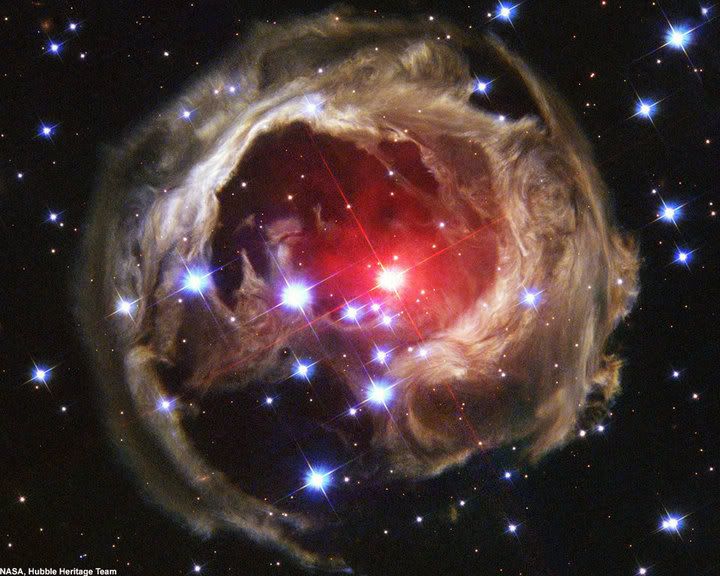Celestial Blossom

(Credit to its owner)

Light Echo
V838 Monocerotis, means the 838th variable star in constellation Monoceros (the Unicorn), is 20 thousands lightyears away from us,
which means its "present" image we observe on Earth NOW is in fact 20 thousands years ago.
V838 Mon was unnoticed until its sudden outburst in 2002.
Its light was reflected by the surrounding dust to form a ring of light echo in 2003,
and it seemed "expanded" faster than the speed of light from our point of view.



The truth is light echo is not the materials expelled out from the outburst of the star.
It is the ripple of light travelled throught the unobserved dust.
The echo is fading to darkness these days.
Also, the light echo did not travel faster than the speed of light, it was an optical phenomenom called "Superluminal Motion".
Superluminal Motion

Let say A is V838 Mon.
AOE is the earliest lightray travels directly towards the Earth.
ABF is another lightray travels to the dust then reflected towards the Earth.
OB is the radius of the light echo, which is 3 lightyears.
Assume the distance between AB is 5 lightyears, so AO is distanted 4 lightyears,
which means travelling time of light along AB is 1 year longer than that of AO.
If the light from V838 Mon (AOE) arrived the Earth in May 2002, the light reflected by the surrounding dust (ABF) would arrived in the following year.
Such phenomenom misled us to think OB lengthened 3 lightyears within 1 year, which was 3 times faster than the speed of light.

V838 Mon is at the centre of Monoceros.
The constellation is difficult to be distinguished as it is very dim.
It would be rather easier to locate it on the east of Orion (the Hunter), which is one of the most distinctive constellation.


Also, Monocerous lies across the "Winter Triangle", an asterism in the Southern winter sky formed by the brightest three stars:
Procyon of Canis Minor (the Little Dog), Sirius of Canis Major (the Big Dog) and the Betelgeuse of Orion.
Aside from V838 Mon, there are some romantic features within the region of the constellation:
Rosette Nebula (NGC2237, Caldwell 49)

The open cluster in the centre is NGC2244 (Caldwell 60).
Cone Nebula & Christmas Tree Cluster (NGC2264)

The point-shaped feature on the top of the image is the Cone Nebula.
The massive red complex below is the Christmas Tree Cluster.
The New General Catogue idenifies the two as a single astronomical object .
Fox Fur Nebula (bottom right corner) locates within the designation but not officially included.
Hence, the designation NGC2264 refers to more than one object
Close-up of NGC2264

Fox Fur Nebula

Cone Nebula

Overview of the above features in Monoceros

The Rosette Nebula is on the top right of the image.
The bright blue star on the left of the centre of the image is S Monocerotis of the Snowflake Cluster (NGC2264).
To its right there is a pointy object called Cone Nebula.
Between them you can find the Christmas Tree Cluster.
On the right of S Mon there is a Fox Fur Nebula.